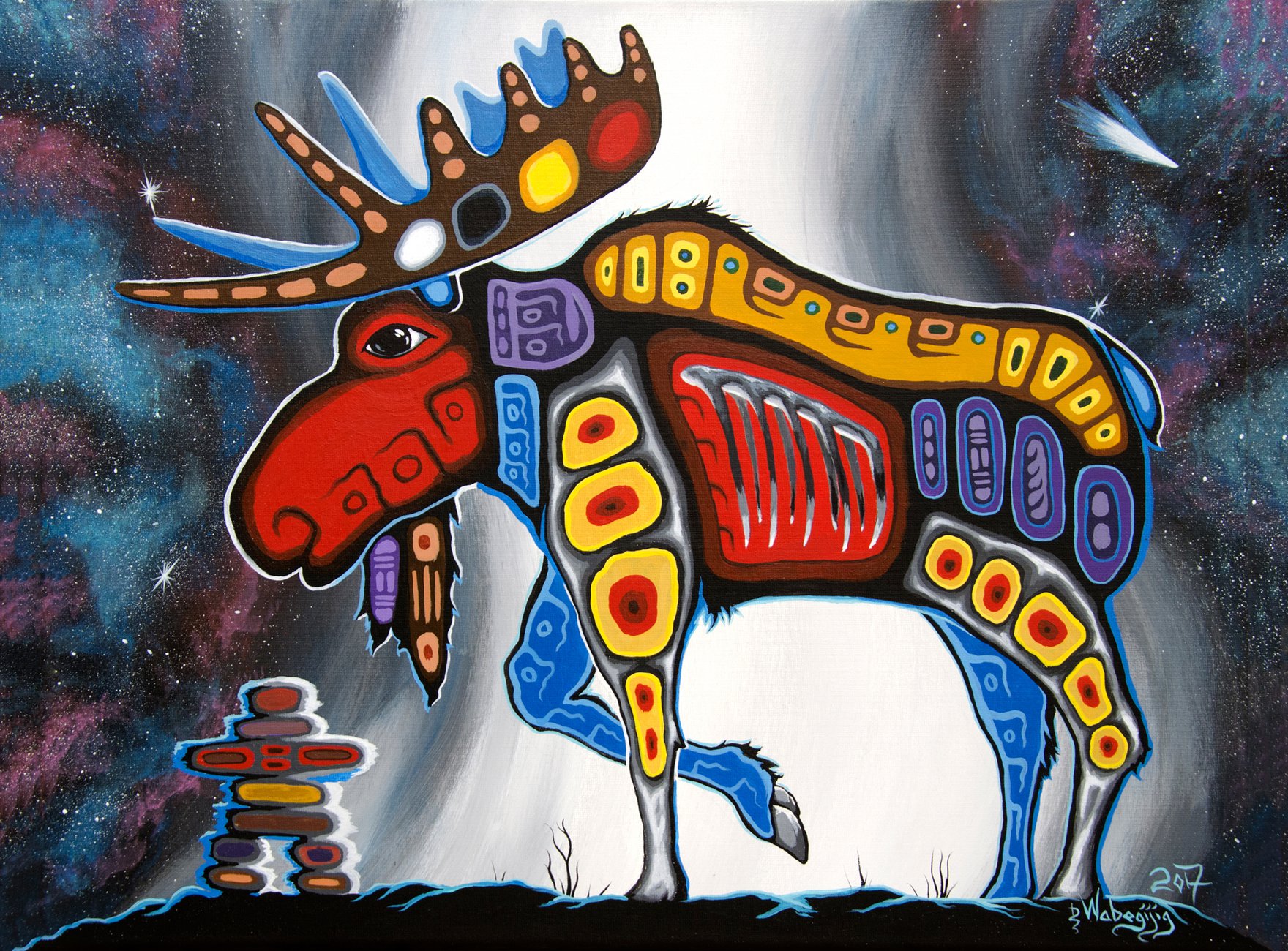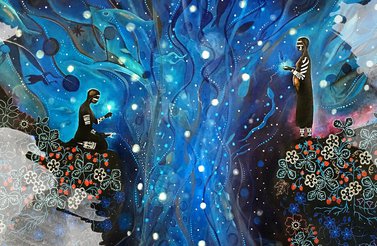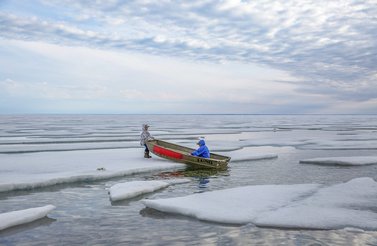Something unique happened at the closing plenary of the Subsidiary Body on Science and Technological Advice (SBSTA) of the twenty-fourth Conference of the Parties (COP24) to the United Nations Framework Convention on Climate Change (UNFCCC) in Katowice, Poland. In an extraordinary departure from protocol, the SBSTA chair, Paul Watkinson, ceded the floor to a representative from the Indigenous Peoples’ Caucus (rather than a representative of a party) to speak first to the conclusion of the negotiations on the Local Communities and Indigenous Peoples Platform (LCIPP).
That representative was François Paulette, a Denesuline Elder, hereditary chief and spiritual leader from Denendeh, living in what is now known as the Northwest Territories, Canada. His message was a clear olive branch from the world’s Indigenous peoples to parties: “Indigenous peoples’ traditional knowledge is infinite. We have lived with Mother Earth for thousands and thousands of years without destroying it. Western science has its limits, and that is why the Indigenous peoples are here to help you stop what is happening during the desecration and destruction of Mother Earth....If Indigenous [peoples] were one hundred percent participants in this forum, we could reach the 1.5 degree target.”
Since the adoption of the Paris Agreement and the Paris Decision in 2015, Indigenous peoples and party representatives have been working in partnership to breathe life into paragraph 136 of the agreement. The establishment of the LCIPP indicated a renewed interest in the contributions that Indigenous peoples can make in addressing the climate crisis. This interest carried through the last three years, driven in part by publications such as The Special Report on Global Warming of 1.5°C by the Intergovernmental Panel on Climate Change, and Canada in a Changing Climate by the Canadian National Assessment. This work has started corroborating the calls, observations and fears held by Indigenous peoples in a rapidly changing climate.
For many reasons, COP24 and the decision on the platform was an important procedural moment for the inclusion of Indigenous peoples in the UNFCCC. Still, there is work to be done to advance Indigenous peoples’ participation, voice and leadership at the national and international level, as we confront the greatest environmental challenge of all: the climate crisis. Indigenous leaders, such as Sheila (Siila) Watt-Cloutier and Vuntut Gwitch’in First Nation supported by Chief Dana Tizya-Tramm, have used international fora to hold states accountable to their climate agreements. Arguably, the LCIPP is an important institutional step to amplify these voices.
A Brief History of Indigenous Peoples’ Participation in the UNFCCC and the Paris Agreement
Indigenous peoples have long participated in the UNFCCC, and the United Nations more broadly, to ensure that their rights, knowledge and jurisdiction are safeguarded by the decisions adopted there. This was formally recognized in 2000, when Indigenous peoples were included as a formal constituency within the UNFCCC with specific rights to participate as observers in the climate negotiations.
To provide structure for the constituency, Indigenous peoples organized themselves in the International Indigenous Peoples' Forum on Climate Change (IIPFCC) in 2008. The IIPFCC helped coordinate Indigenous peoples attending the UNFCCC to discuss priorities, negotiate items and hold side events in a culturally safe space. The forum aims to unify and amplify the voices of Indigenous peoples while maintaining that individual organizations at the subnational, national and global levels have their own agendas, priorities and proposals to advance at the UNFCCC.
Since 2008, and long before the Paris Decision in 2015, parties to the UNFCCC have been considering the role of Indigenous peoples and their traditional knowledge in global climate action. This has been represented by more than 60 decisions adopted by COP, or in reports adopted by subsidiary bodies that explicitly reference Indigenous peoples and traditional knowledge. The Paris Decision text maintained this momentum, referencing Indigenous peoples or traditional knowledge six times. Central to these references was a recognition that climate change poses a considerable threat to the realization of human rights, especially the rights of Indigenous peoples; the Paris Agreement stressed that parties “should, when taking action to address climate change, respect, promote, and consider their respective obligations on human rights,” including the rights of Indigenous peoples.
The “Operationalization” of the LCIPP
At COP23, the LCIPP was further operationalized by a decision that outlined the objectives, functions and purpose of the platform, and charted a future direction for the establishment of a facilitative working group (FWG). Despite a lot of momentum at the intersessional in 2018, several sticky issues, such as the protection of territorial integrity and political unity in response to the inclusion of the United Nations Declaration on the Rights of Indigenous Peoples (UNDRIP) in the decision text, prevented the negotiations from advancing and instead were punted to COP24 in Katowice.
At COP24, after a full week of formal negotiations and many hours of intense bilateral and trilateral negotiations, the decision on the platform was officially gavelled on December 12, 2018. Negotiators, Indigenous peoples and other representatives celebrated this momentous decision with a final informal session that, perhaps serendipitously, was also Indigenous Peoples Day — the day set aside at COP to highlight Indigenous peoples’ involvement in climate action.
The decision was a positive step for improving the participation (and protection) of Indigenous peoples in the UNFCCC. In the context of UNDRIP, the decision creates the first-ever constituted body (the FWG) that has equal representation between party and non-party representatives (Indigenous peoples), and enables Indigenous peoples to self-select their representation according to their respective processes and protocols. This is an important point to emphasize: Indigenous peoples can self-select their representatives, which could incrementally challenge the party-driven process of the UNFCCC.
This was step one; the FWG is now tasked with developing the platform in a way that honours Indigenous peoples’ resilience, knowledge and rights, including those affirmed in UNDRIP. This work begins in June 2019 at the first FWG meeting, where representatives will jointly develop the platform’s initial work plan based on its three functions. This won’t be easy, as many of the incongruities between representatives from states and Indigenous peoples will likely surface in its elaboration.
One such incongruity is the scope and vision of the FWG and the eventual platform for Indigenous peoples’ participation. Elder Paulette, in the opening quotation, spoke to the importance of including Indigenous peoples as “one hundred percent participants” in the UNFCCC. This is particularly challenging in a party-driven process, but it is expected that Indigenous representatives will use the FWG to advance a “subtle revolution” (a term drawn from Sheryl Lightfoot’s 2016 book Global Indigenous Politics: A Subtle Revolution) to have discussions on how Indigenous sovereignty, rights and knowledge could enter mainstream UNFCCC discourse.
Another incongruity is that the platform may “silo” Indigenous peoples’ concerns. There is a fear that parties may construe the platform as a one-stop shop for all things Indigenous in the UNFCCC, disregarding more than 60 decisions in other policy areas, as well as the interests of Indigenous peoples to participate in other agenda items.
It is also important to note that the creation of a platform, even with the FWG, does not reduce the barriers that Indigenous peoples face in participating at an international level. The authors of the 2019 article “Pursuing an Indigenous Platform: Exploring Opportunities and Constraints for Indigenous Participation in the UNFCCC” outlined three categories that merit further exploration: material constraints (funding, badges and lack of translation), procedural constraints (closed meetings, uneven access and scientific/technical jargon), and recognition-based constraints (lack of political will, disrespect, tokenism and the physical/emotional toll of attendance).
On a personal note, the physical and emotional toll of attendance is something that we carry on our shoulders as Indigenous representatives. Even as the climate crisis threatens our spiritual, environmental and cultural existence in our lands and territories, parties spend hours arguing about whether they should “take note” or “welcome” the IPCC’s special report on global warming, for instance. For parties who continue to delay and prevent meaningful climate action, a Maori relative articulated an important benefit of Indigenous participation at the UNFCCC: “We are here to remind negotiators, and their states, that we are still here, and we are still fighting. There are people in our communities, on our mountains, and in our rivers that are behind the text, behind the commas, brackets, and full stops.”
Breathing Life into the Indigenous Peoples Platform
In 2012, Ken Coates wrote about the challenges shared by Indigenous peoples in North and South America regarding Indigenous internationalism — the challenges of bridging the frequent gap between domestic and international situations. Questions remain on the relevance for the FWG, and more broadly the LCIPP, for those Indigenous peoples currently living in Canada and facing existential environmental challenges elaborated in this series. However, as explained above, Indigenous peoples have long been using international fora to advance their issues and hold states accountable for the abuses against them. Take, for example, the work that Watt-Cloutier has been doing over the last two decades to bring a human face to the climate crisis.
In the creation of the Paris Agreement, parties shifted the locus of climate action from the international to the domestic, requiring the annual collection of nationally determined contributions (NDCs), which outline how each party will reduce its emissions in line with the commitment to 2°C. This shift is exemplified in the Paris Agreement’s rights-based protections (noted above). Eventually those protections, and safeguards, made their way into the Pan-Canadian Framework on Clean Growth and Climate Change (PCF). The international community has long recognized that climate change poses a considerable threat to the realization of human rights, especially the rights of vulnerable people and the rights of Indigenous peoples. Having been in the room, I saw that the inclusion of these rights in the PCF was largely the result of First Nations, Inuit and Métis leadership at the negotiating table.
The challenge, however, is that Canada’s current NDC is wildly insufficient — putting the world on a pathway to 4°C warming over pre-industrialized levels, on average. It also doesn’t respect the science (and transformative changes) outlined in the IPCC report, nor does it align with the rate of warming in the North outlined in Canada in a Changing Climate. Into this void, First Nations and other Indigenous peoples are stepping up to prevent the rise of global temperatures above 1.5°C levels. One such example is the Vuntut Gwitchin First Nation, which, with the support of their community and Chief Dana Tizya-Tramm, have declared a state of emergency. The declaration, titled “Yeendoo Diinehdoo Ji’heezrit Nits’oo Ts’o’ Nan He’aa,” translates directly to “After Our Time, How Will the World Be,” saying the traditional way of life in Old Crow is under threat from the climate crisis. Clearly, Indigenous peoples’ voices need to be heard at the UNFCCC to illustrate the impact that the climate crisis is having — and will have — on the health of animal populations, food security and communities’ emotional, cultural and physical well-being. Further, their voices will demonstrate the leadership required for addressing this climate crisis in Canada and globally.
Next Steps
Clearly, the recent changes at the international level are an important starting point. Much work is left to breathe life into the FWG and the platform itself in a way that safeguards Indigenous self-determination, Indigenous legal orders and Indigenous-led solutions in addressing the climate crisis. At a domestic level, work is clearly underway as Indigenous peoples push governments to increase climate ambition, safeguard human and Indigenous rights, and ensure the respectful and appropriate consideration of Indigenous knowledge systems.
The ultimate success of the FWG, and the platform more broadly, will depend on how well it can amplify these voices and speed up transformative change amid the real, immediate and existential threats that First Nations and other Indigenous peoples are facing daily across Canada and internationally.
About the artist: Dwayne Wabegijig is an Ojibwe artist based in Thunder Bay, Ontario, Canada. He has been painting since he was 20 and works primarily with acrylic on canvas. His work is a contemporary take on the traditional woodland art of those who came before him. Examples include Morrisseau, Carl Ray and James Simon Mishibinijma. He continues to do shows in the northwest of both Canada and the United States.


